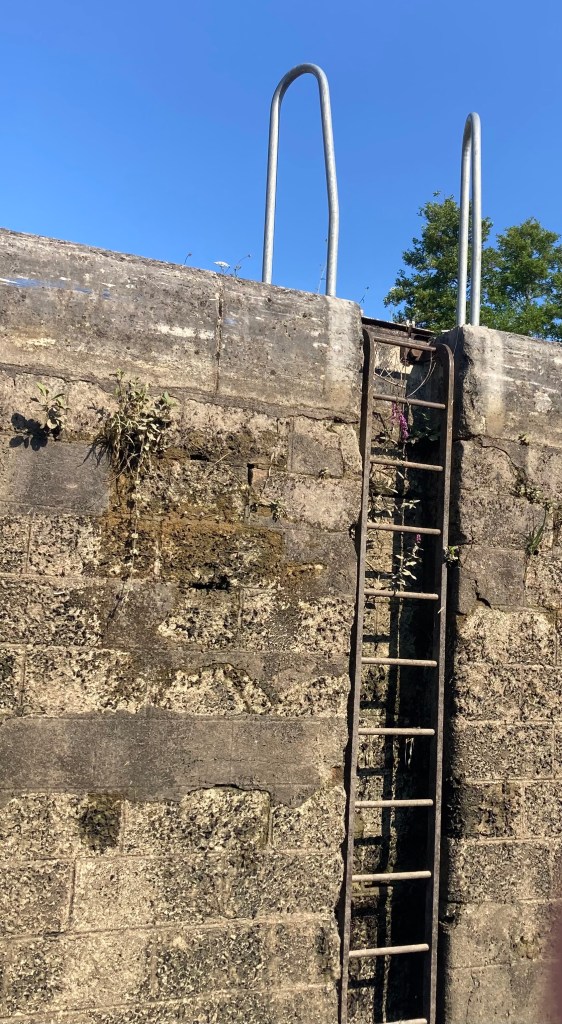9th to 18th July 2023
I’m trying out a new style, using the names of the places we stayed as headings. Let me know what you think.
Briare
The Canal de Briare is reputedly the oldest canal in France. It sort of has to start at Briare doesn’t it, or end there, or both? We joined it after the Canal Latèral à la Loire had crossed the marvellous aqueduct, skirted round above Briare, and ended at a Y junction with Canal de Briare, see the blog on Latèral a la Loire part 2.
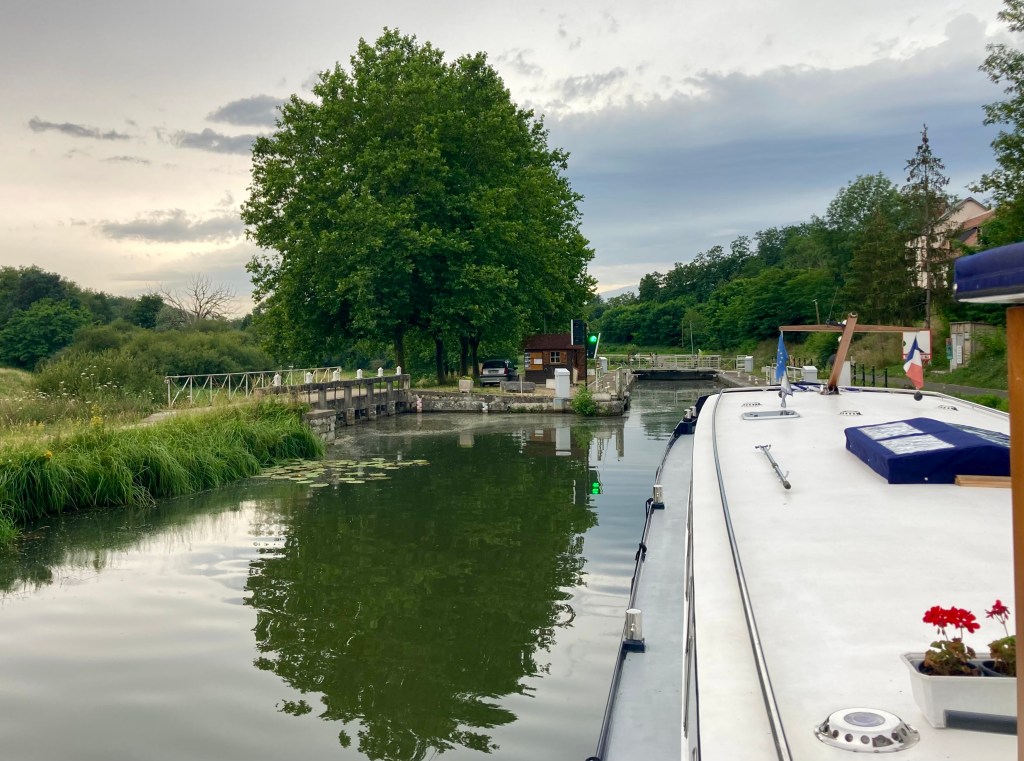
Calliope came up one of the two forks of the Y and had to turn into the other fork – at the same time as entering a lock. A very friendly éclusier (lock keeper) was on hand to help, though Captain Stu brought Calliope in perfectly and it was easy for me to lasso a bollard.
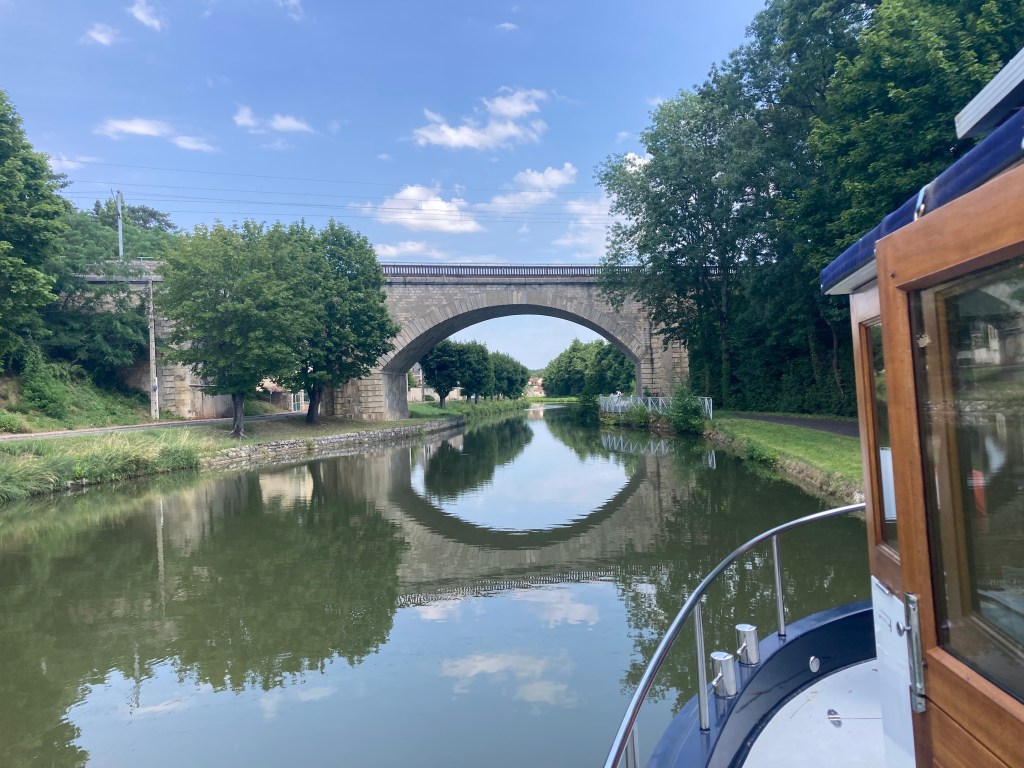
That lock, plus another a kilometre further on, took us down into the town and to the end of the port where we had been asked to moor below the railway viaduct. It is quite a big port and many boats are moored just through the third lock.

The Briare mooring provided lavoir number 1 – the longest lavoir I have seen in my long lavoir travels. And we were right next to it. I discovered that it is part of what was a public wash house, including rows of lavatories in wooden cubicles, and maybe baths for people inside. I have written off for more information, but not received it yet.

Someone has taken the time to collect some of the everyday items the washer people would have used.
These include 3-sided wooden boxes that they knelt in to keep themselves dry while doing the washing.
The lavoir is in a side waterway to the canal and I noticed at least another two smaller lavoirs along its length; it must have been frothy from soap suds in its day.

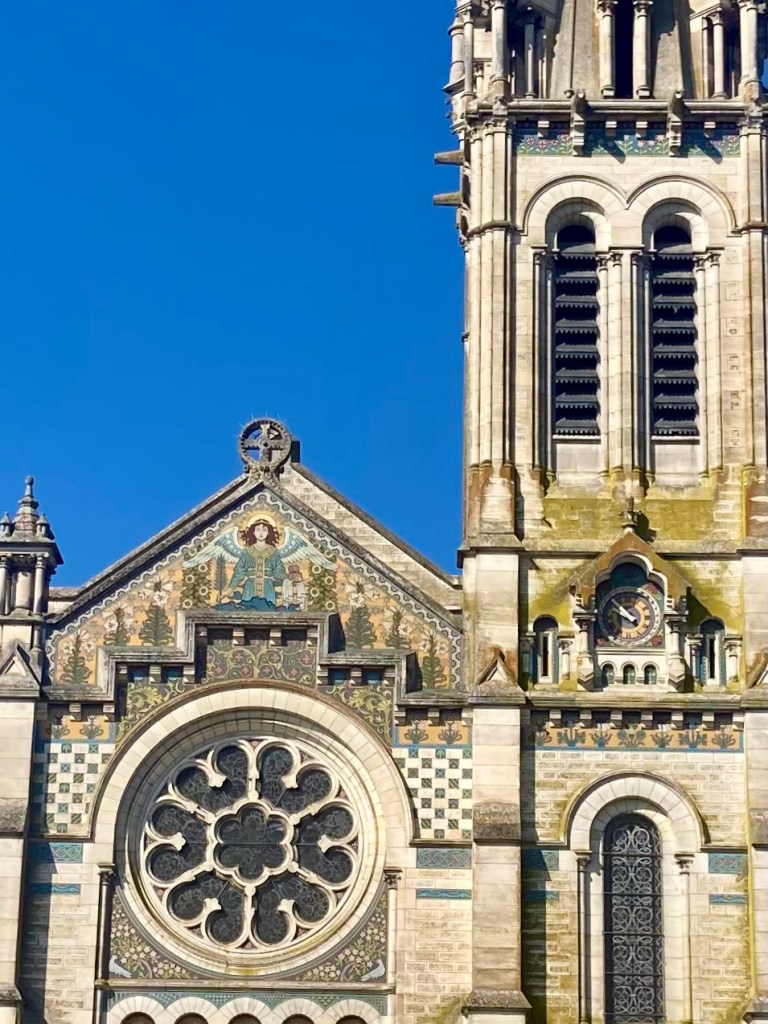


We managed to catch Briare at its quietest, arriving on a Sunday. Our wander round took us past the magnificently landscaped town hall , the church with its colourful mosaics (inside and out), and some other interesting places, but on both Sunday and Monday the town centre seemed so quiet that we thought it was rather a dead town.
We made sure we got back down to the banks of the Loire so that we could see the aqueduct from another perspective. Just behind us when I took this photo is the ‘ancien canal latèral’ – the canal that was used by barges before the aqueduct was built. They had to make the sometimes dangerous crossing of the river further upstream, from Chatillon to Combles and then join the old lateral canal down to Briare.
Then come Tuesday, the day before we left, everything opened up – bars, shops, restaurants – and it is quite a vibrant town!

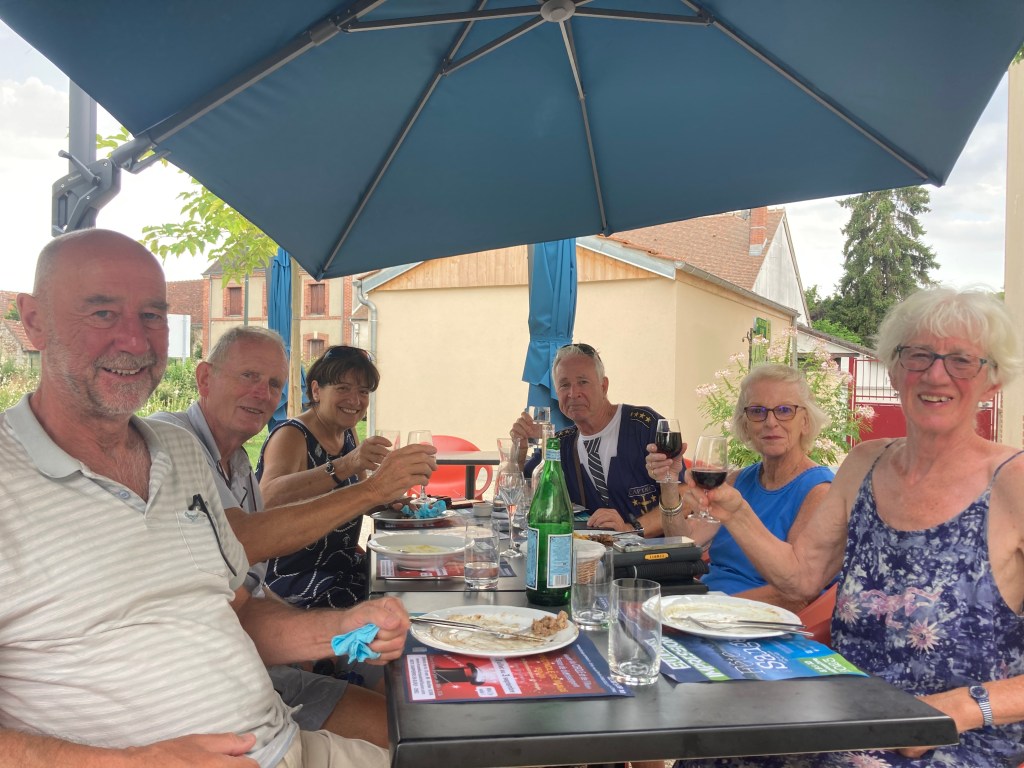

We had a lunch date for Tuesday, at a good little restaurant the far side of the famous aqueduct so we walked over it to meet our friends and have a good time meal.


Then that evening a final walk round the port to appreciate it in a lively mood, and to appreciate the lights on the buildings and monuments, before a suitably early night.
Ouzouer-sur-Trézée
We had decided to leave on Wednesday, first saying good bye to Danish, UK and Australian boat friends who we had met along the Loire.


Our journey began by retracing our route of 3 days before, up through two locks to the junction with the Canal latéral à la Loire. The first lock, la Place, is only 2.3m deep and next to an old water mill. The second, la Cognadière, is deeper, 4.27m, and manned by a very helpful élcusier (lock keeper) who makes sure boaters can get their ropes onto the bollards above.

Leaving la Cognadière (on the right) we could look back and see the Latèral à la Loire (on the left) winding its way round to the aqueduct. It is an unusual shape junction, and interesting to negotiate at times!
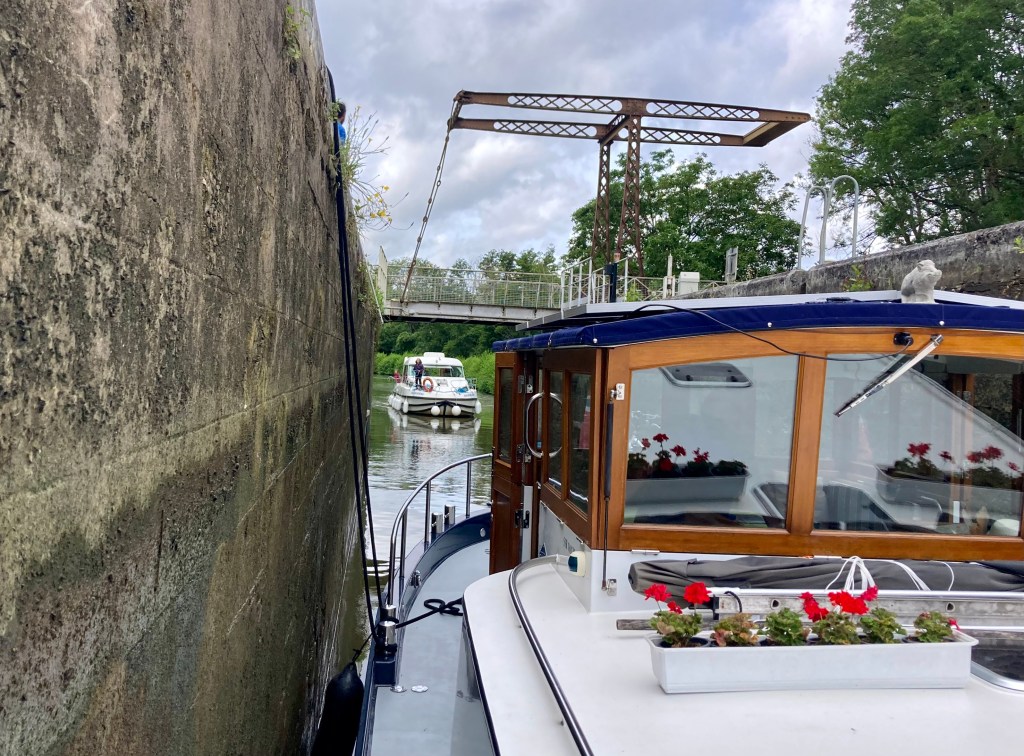
We had just two more locks that day to a hopeful mooring at Ouzouer, and were joined in them both by a family on a holiday boat.
Wild flowers abounded, including on the lock quays.

As always we had a Plan A and some other plans if needed. We knew that we could not stay at Ouzouer on the Thursday night (the canalside was taken over for fireworks on July 13th; this happens a lot in France on the eve of their Bastille Day celebrations.)

But we were fine for the Wednesday night and tied up comfortably next to a small park on the edge of the village.
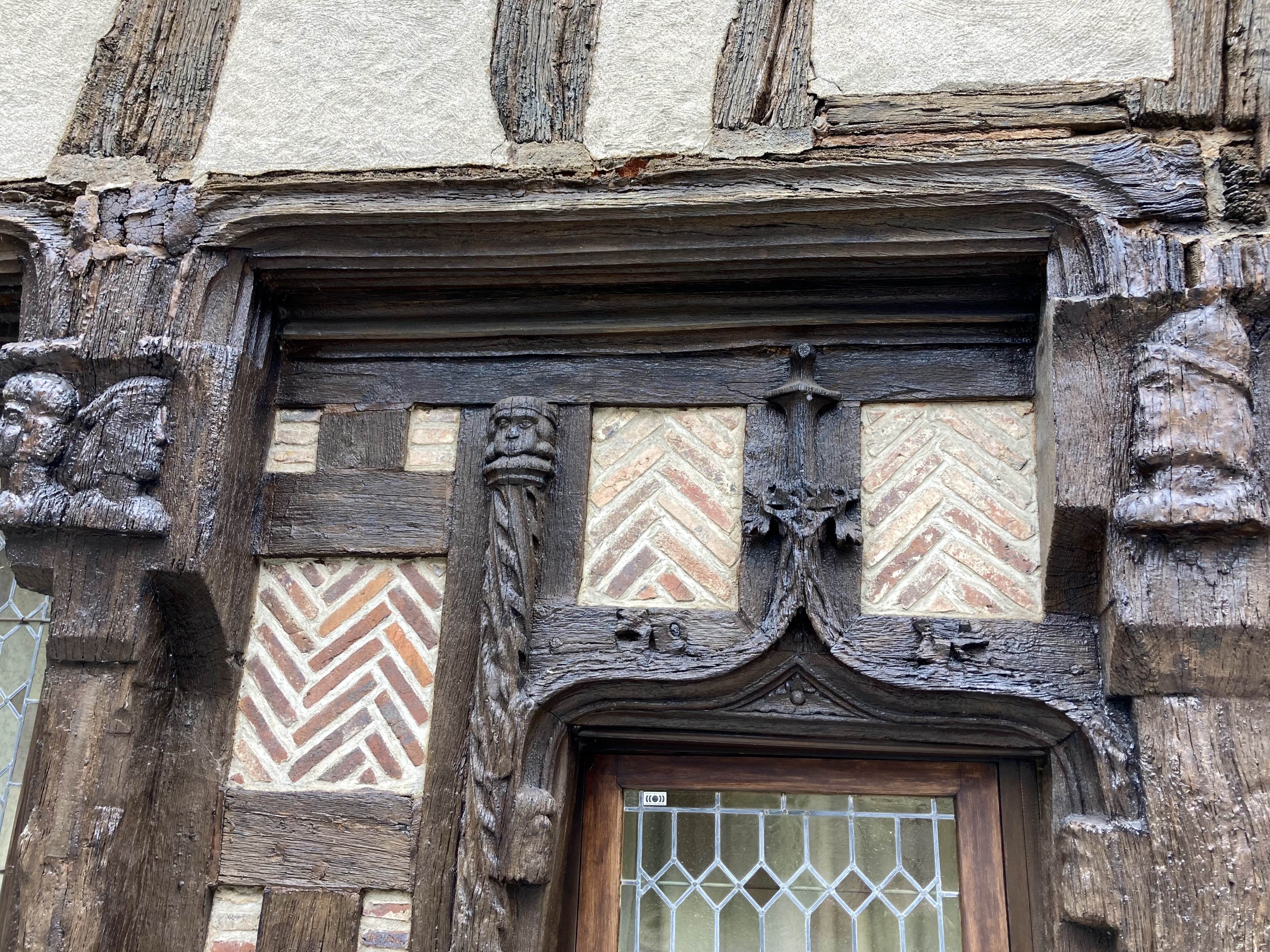
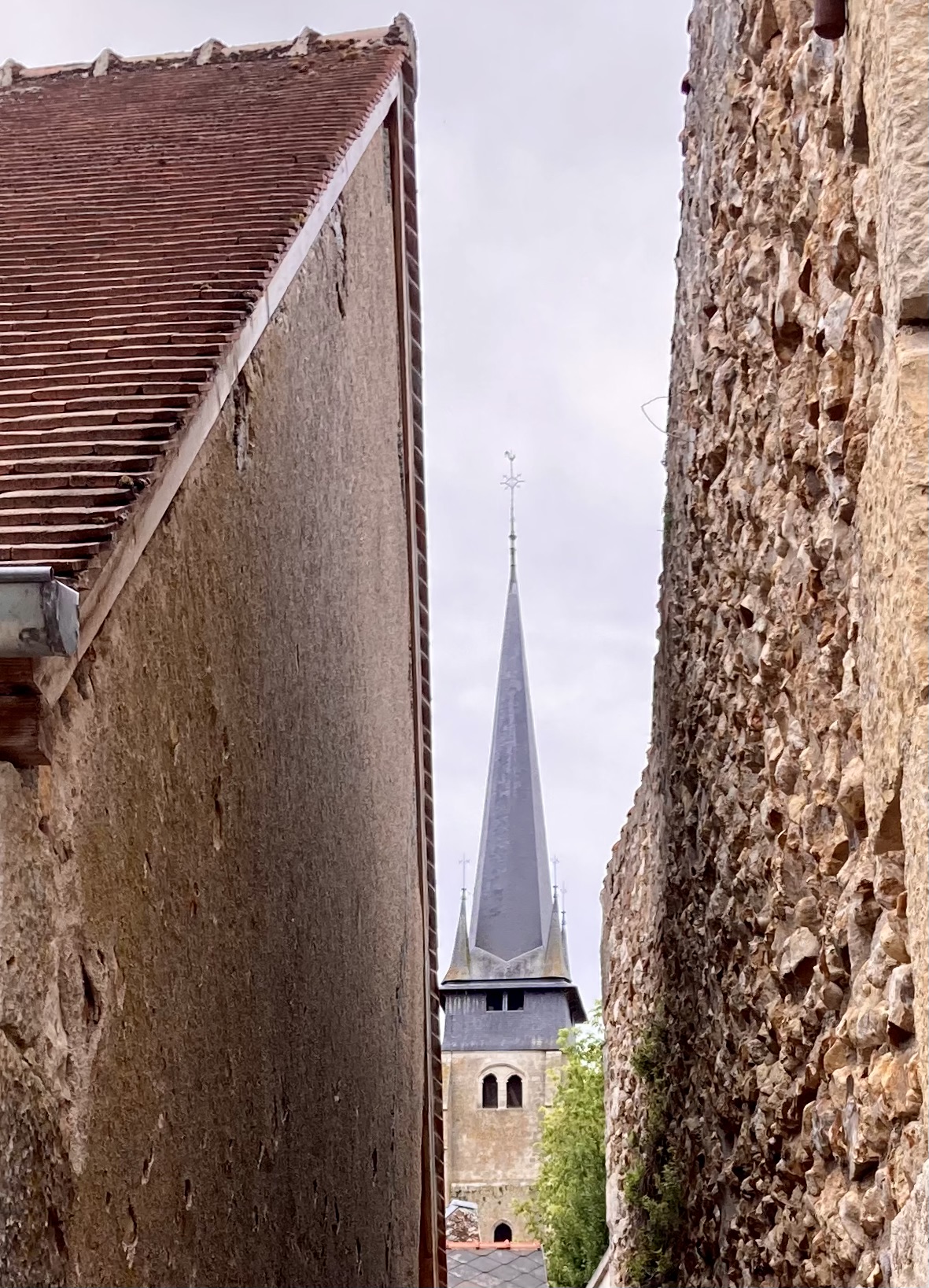

I am constantly impressed by the old houses and other buildings in all the villages, and at risk of repeating myself. Let me just say that in Ouzouer there were two or three that caught my eye.
And sadly I also couldn’t help but notice how what had been a busy little high street was now a row of closed shops and businesses. The one big ray of hope was Epicerier Tréz, down near the bridge, where a jovial Frenchman is running a very modern looking small food shop, stocked with fresh milk, cheese, butter, meat etc from nearby farms, fresh fruit and veg and an interesting range of both basics and specialities – food and drink!


My evening stroll brought in a couple more photos that capture the spirit off France.
Etang de la Gazonne
We were looking forward to our two nights at the top of the canal where a largish lake acts as a reservoir to supply the canal. The mooring is along a stretch of land about 12′ wide that separates the canal from the lake – you can imagine how wonderfully scenic and full of birdlife that is.

Leaving Ouzouer in the morning we saw the village getting ready for its celebrations.
A stage, beer and food tents, and the typical rows of long tables with chairs either side were signs of a good night ahead.
It seemed strange after just one night on this canal to already be heading for the summit. Today’s 6 locks, 4 kms and 21.5m rise took us to the top – and took us three hours to accomplish.
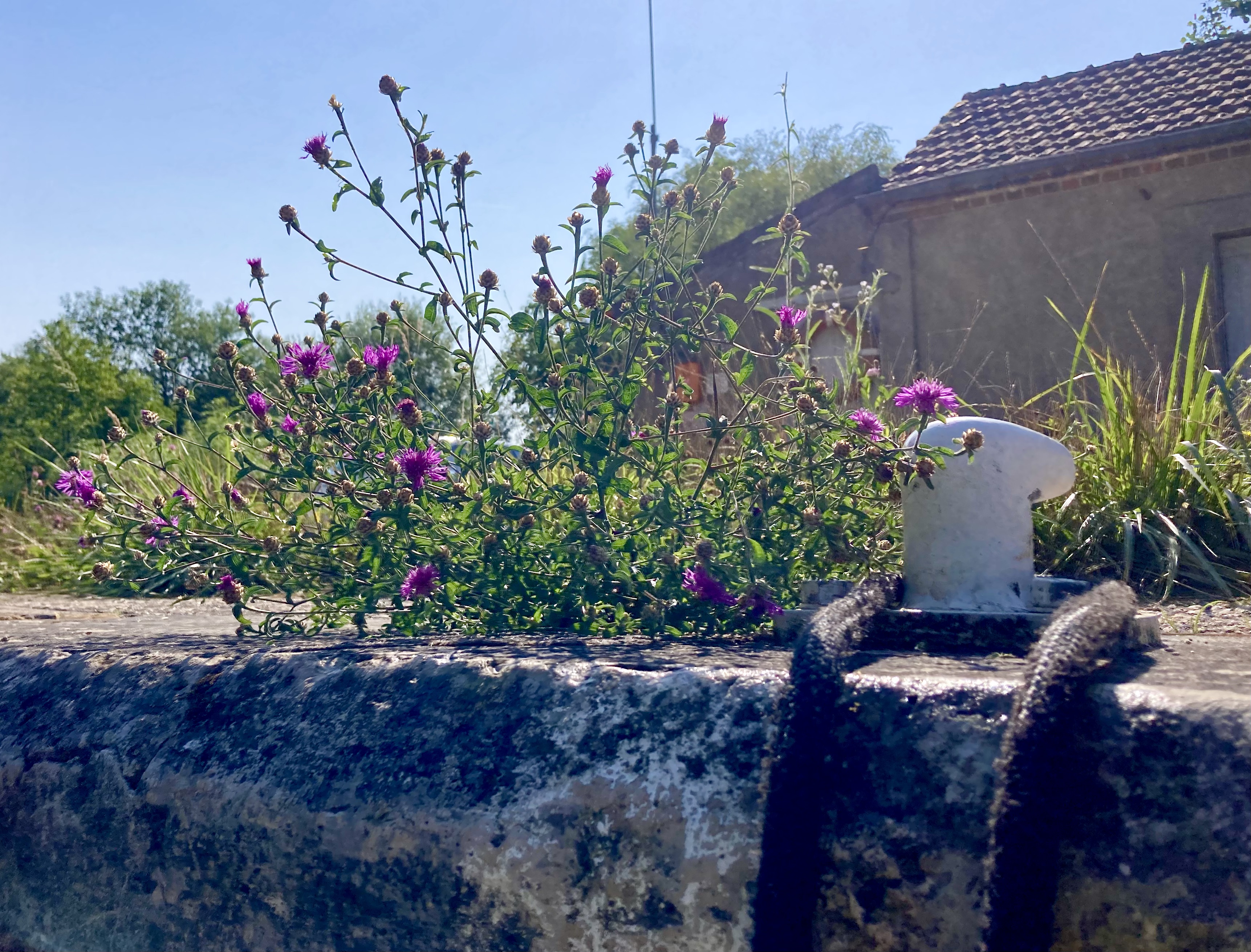



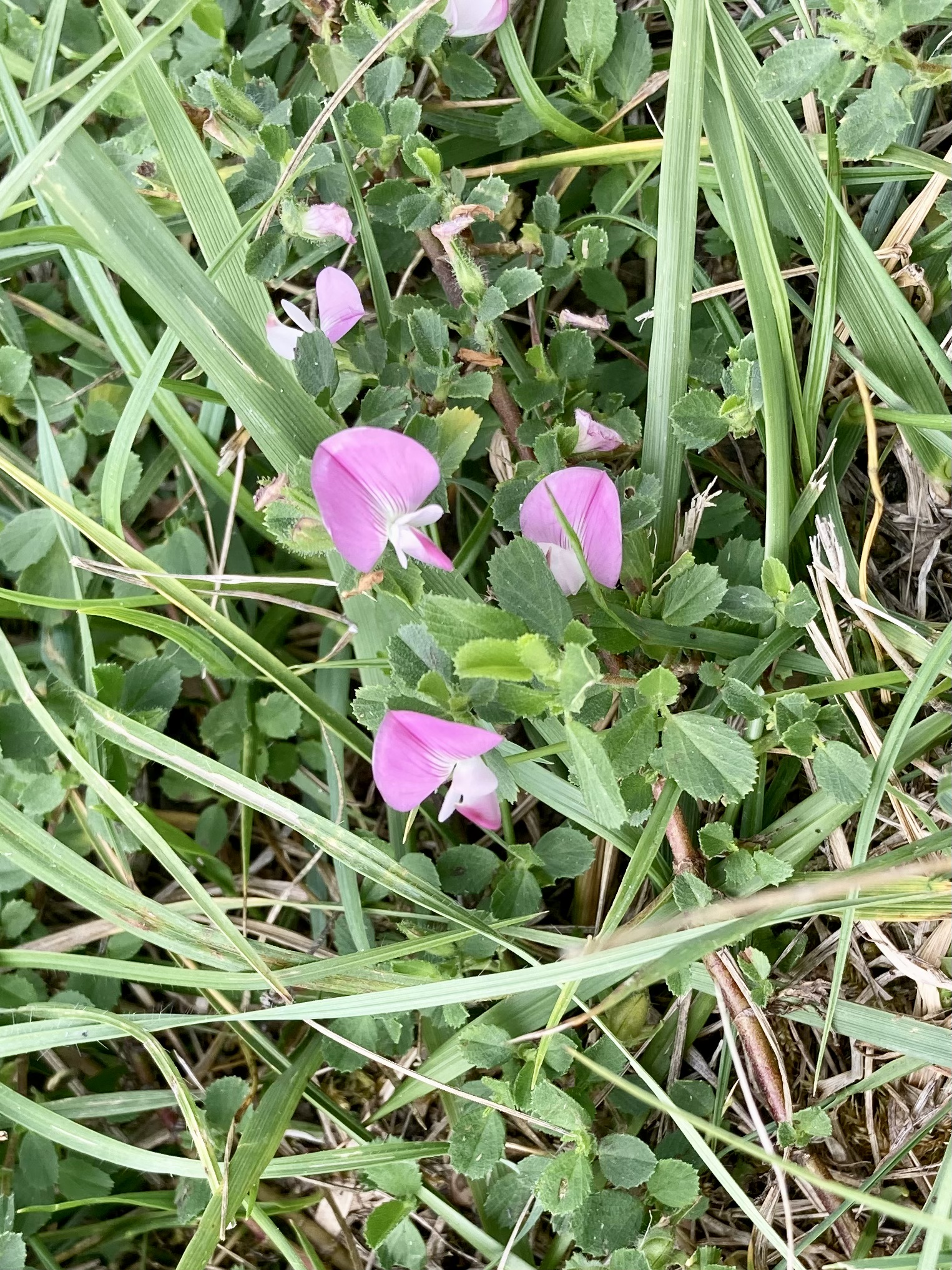

Before I describe something of the locks we went through I am sharing some of the flowers along the way – poking their heads above the grass everywhere. Most, if not all of them, are common flowers, but striking in their impact.
And now the locks.
We had been grateful of éclusier help in the deeper locks going up, but we were on our own for the 4m lock leaving Ouzouer.
The ladder was Captain’s end of the boat so he got to climb up this time.
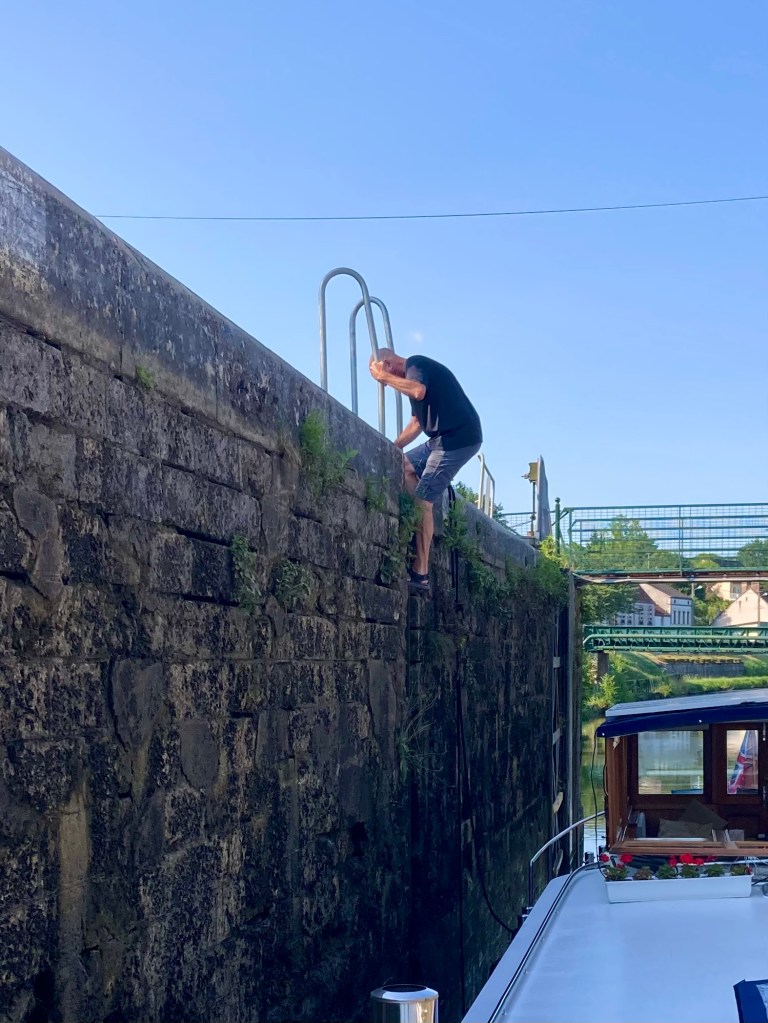
On this canal we had green poles to set the lock operation going – other times it is a blue pole, or even a blue rope.
When you are going up you are grasping a pole that has spent half its life under water, so always muddy, sometimes weedy …

… and sometimes encrusted with fresh water mussels!
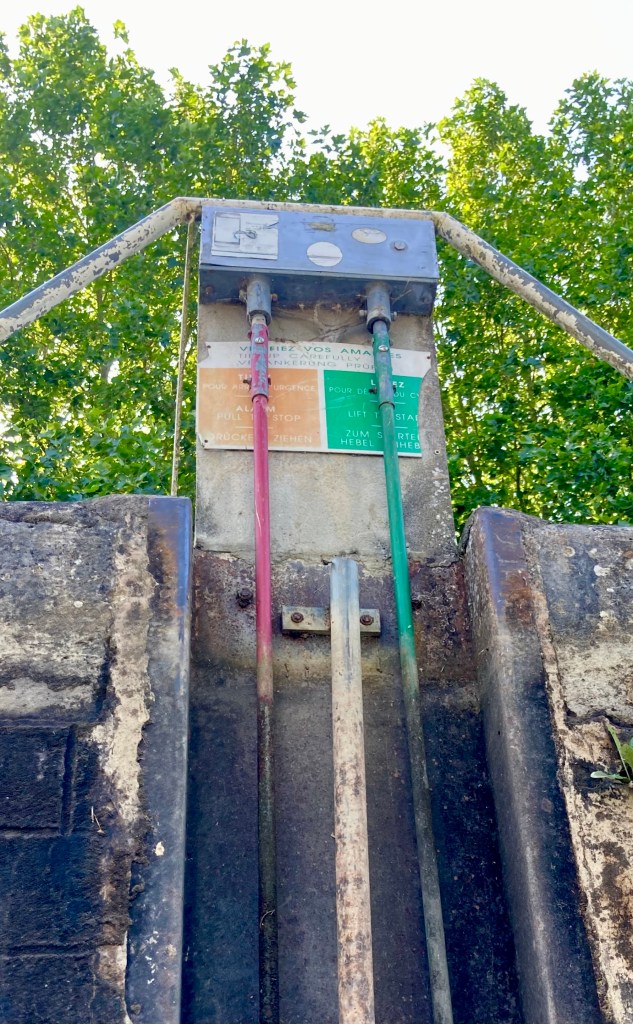
Most of the locks have these lift bridges next to them.

Calliope’s height does not require these to be raised, but I guess some of the hotel barges and maybe the occasional commercial barge are too tall to pass underneath.
I love their architectural shapes against the sky
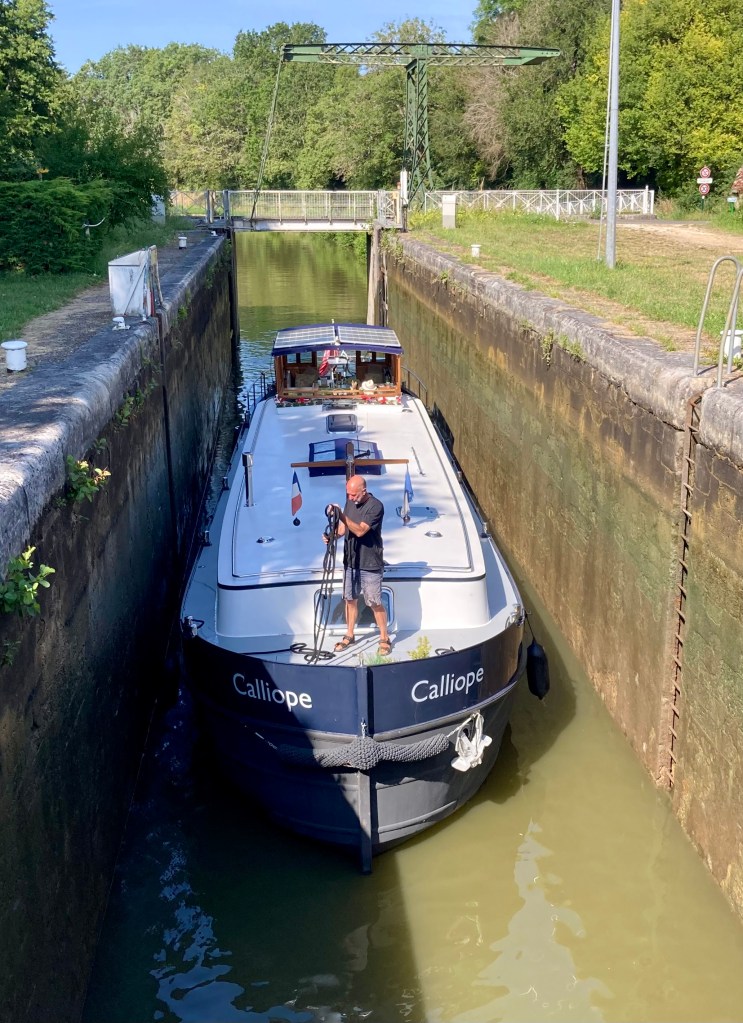
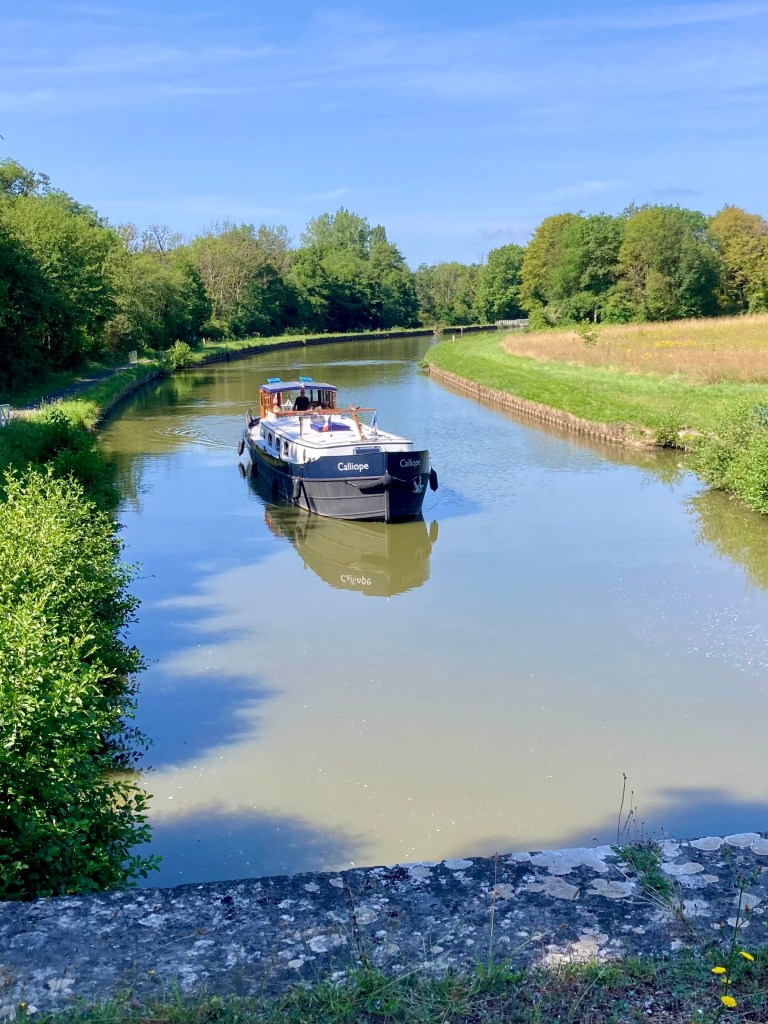
The last few locks were close enough together for me to walk from one to the next, always being above the lock to take the ropes. That made it much easier! It is also a good vantage point to take photos of the sleek Calliope.
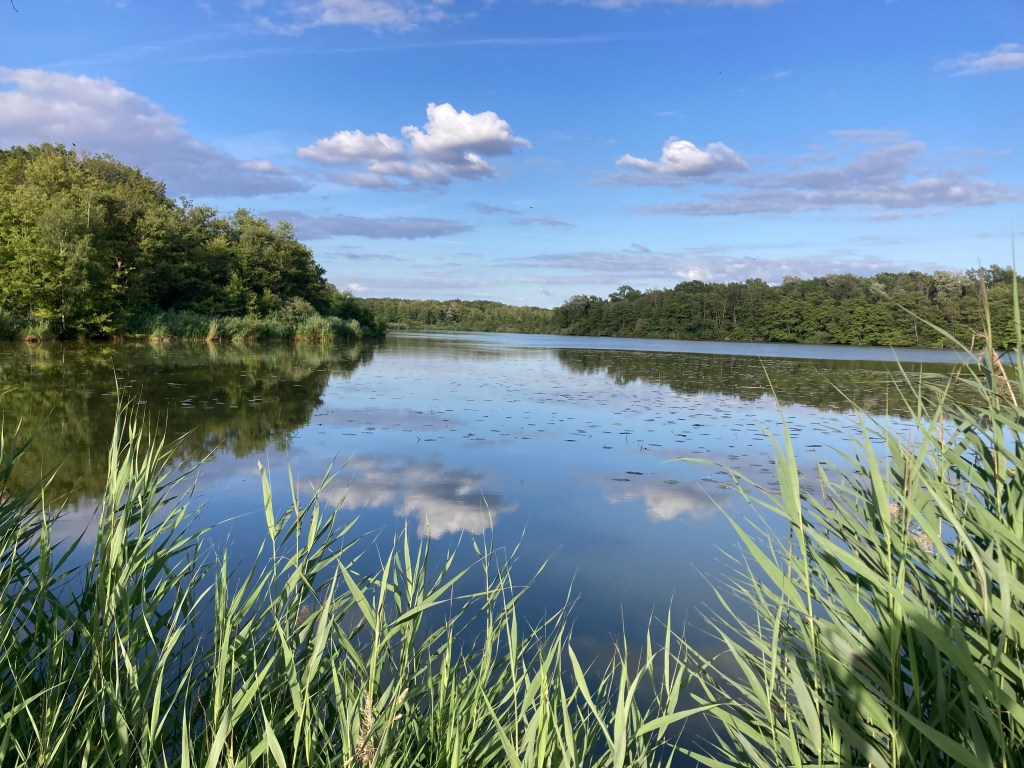
Then the étang (lake) – no houses to photograph up here; just the water and the sky.
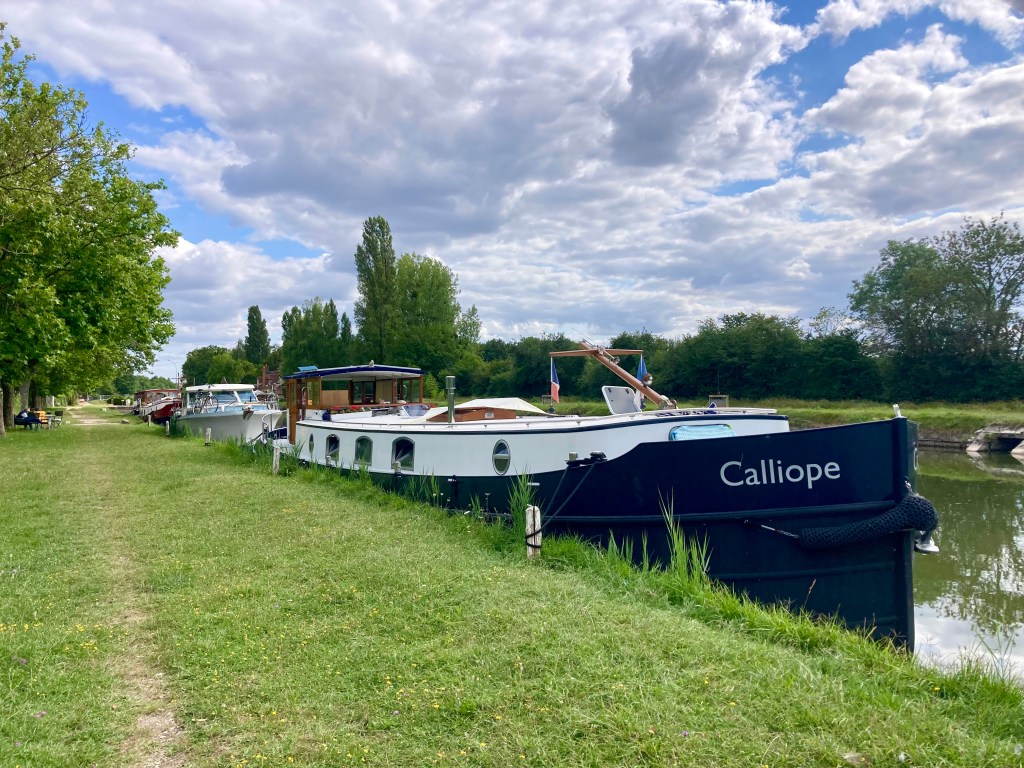
We were sharing the space with two other boats and their peaceful owners; a very tranquil time at the top was had by all.
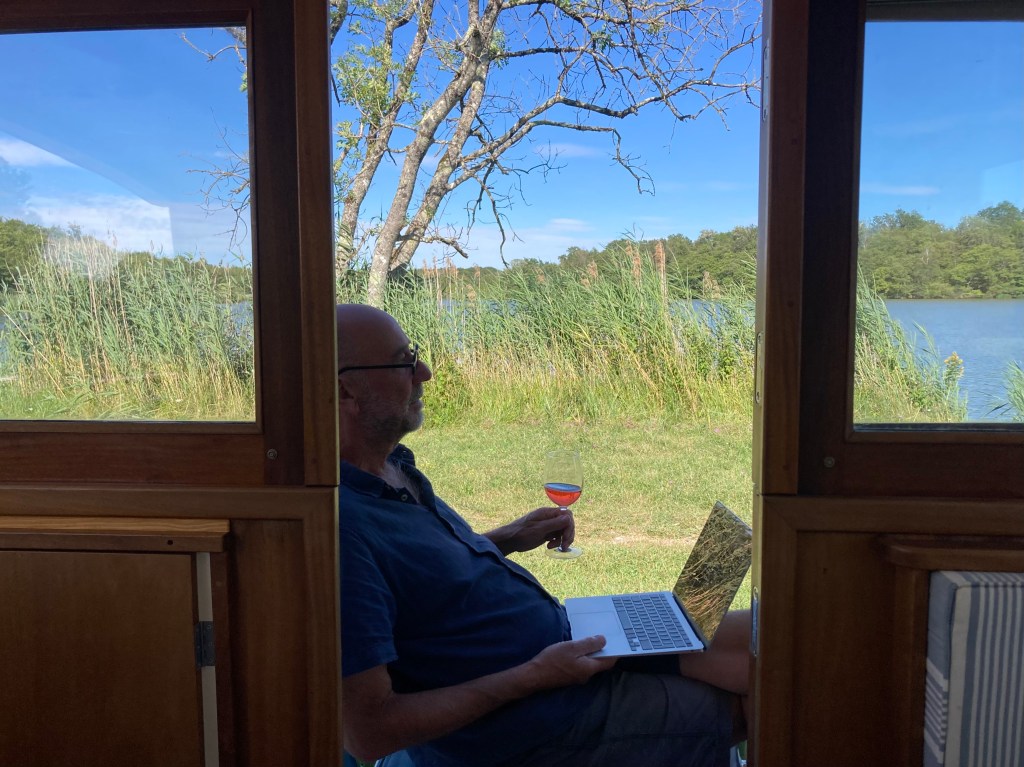
The weather was quite hot, but up by the lake we had rolling breezes and the two evenings in the shade of the wheelhouse were perfect.

And the morning that I bothered to get up to see the dawn (6am) was amazing in the true sense of the word; even I was stunned into silence.
Dammarie-sur-Loing
When we left then lake we began with a straight 4 kms without locks, essentially along the summit plain of the canal, before a drop of 25m through 6 locks to reach Rogny-les-Sept-Écluses.

Those of you with good, or even limited, French will have spotted that we came down 6 locks, but the village has seven (sept) locks in its name. The village is named after the original staircase of 7 locks, now a tourist attraction, but by-passed when the canal started to convey the larger Freycinette barges.
It also needed to change because it was a one way system, resulting in queues of barges top and bottom.

Ou trip down the ‘new’ six lock system was in the company of a cheerful éclusier whon loved to chat to all the onlookers (although on his phone in this photo!).
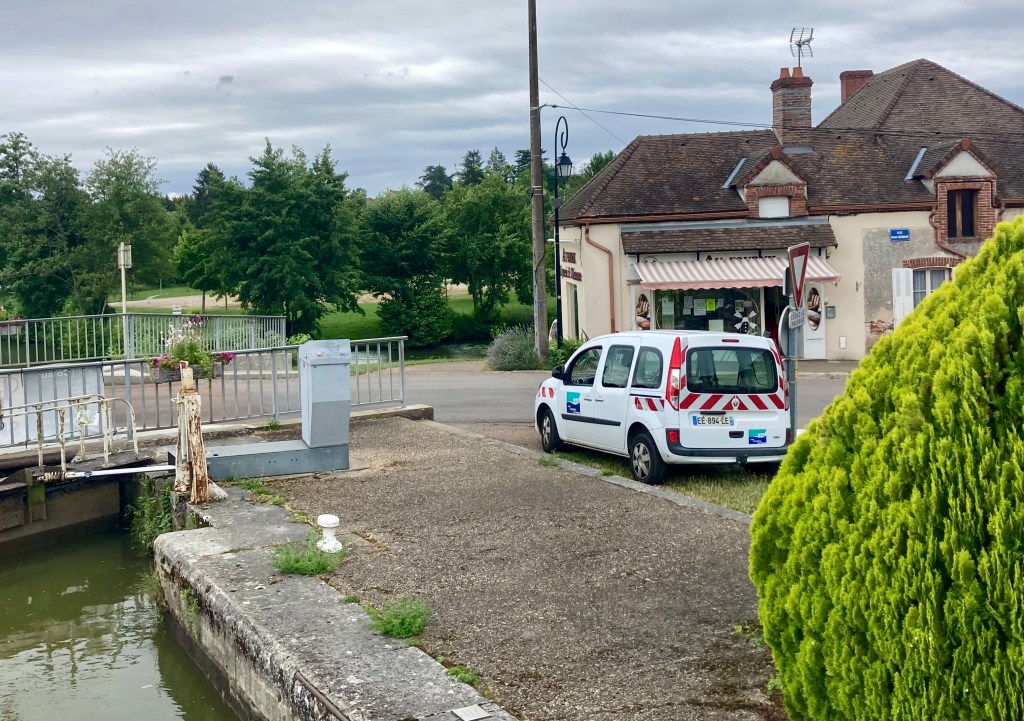
He was happy to wait for us at the bottom lock while I popped into the boulangerie across the road for some bread – and an apple turnover as a thank-you gift for him!
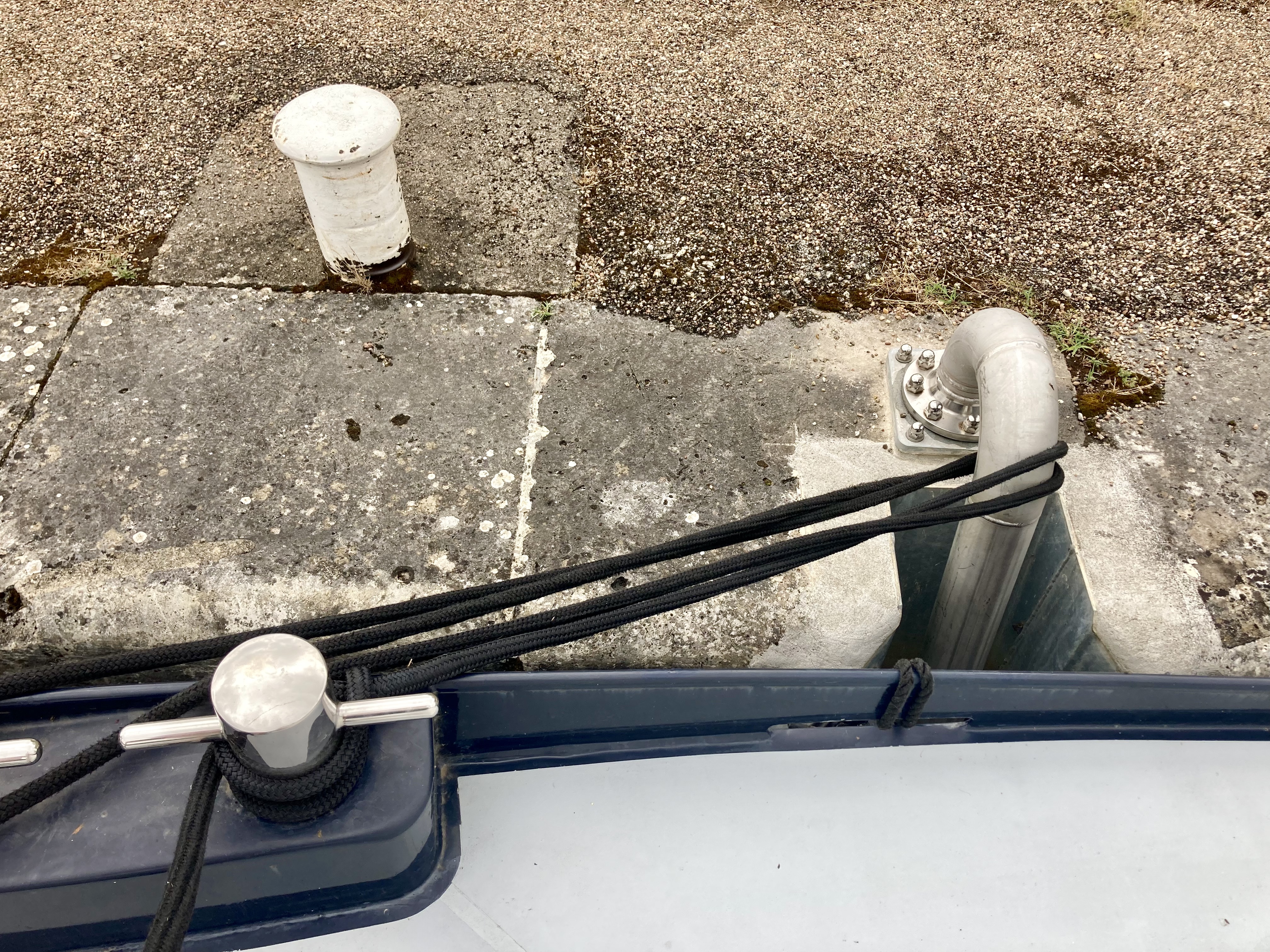

On the way down there was further evidence of the gradual automation of these locks. Strong steel tubes have been installed to make it much easier for boats. Instead of needing to find a bollard when you are at the bottom of a lock we can put a rope round the tube and ‘slide’ up – or in this case slide down.
There was also evidence of past days – a lock keeper’s house now a private residence.
If you zoom in on the photo yup will find the name of the lock, No.14 Racault, in the stone plaque above the door.

Although Rogny-de-sept-écluse is an attractive village we had already decided to carry on to Dammarie-sur-Loing in order to check out a lockside café we had been recommended.

First things first though; Calliope needs her resting place. We found another nice place to moor, sharing the space with a couple of camper vans. The skipper frets sometimes about finding space at our intended evening resting place, though we have been lucky time and again this year. The crew (moi) also remind him that there are plenty of others just around the corner ….

Less than half a kilometre further is Moulin-Brûlé lock where it is possible to see the overgrown vestiges of the ‘ancient échelle du Moulin-Brulé’ – the old staircase lock of Moulin Brûlé.

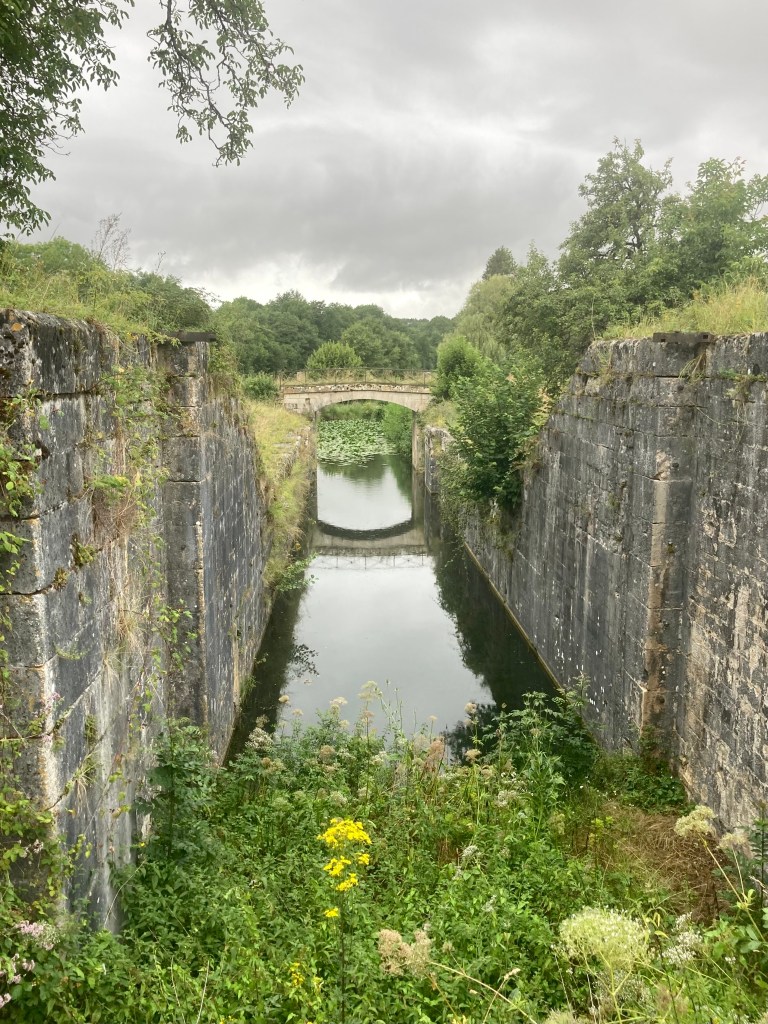
It was rather an overcast day, but I think these two photos give a sense of the place – the old narrow staircase of 4 locks, so busy in their c200 year working life (1642-1830). They have been bypassed for almost another 200 years, making way for longer wider barges. At the time of these old locks the barges were hauled by men, normally two.
There is a good museum at Briare documenting the very interesting history of the canal.
Eventually to the café – based in the old lock house and run by a British couple, it is a small but funky place, with delicious home made pasties and carrot cake amongst a small homemade menu. As we entered the lock, we asked the the éclusier if we could pause for a while two buy two more pasties for the freezer, and would he like a pastry to go with his morning coffee?
‘Mais certainement’ said he, ‘the lemon carrot cake is to die for!’

We bought a few things to take back to the boat …. and the heavens opened! So we stayed and had a coffee and a good chat about the business with the owner .

On the way back, when we reached Dammarie, I made a small detour.

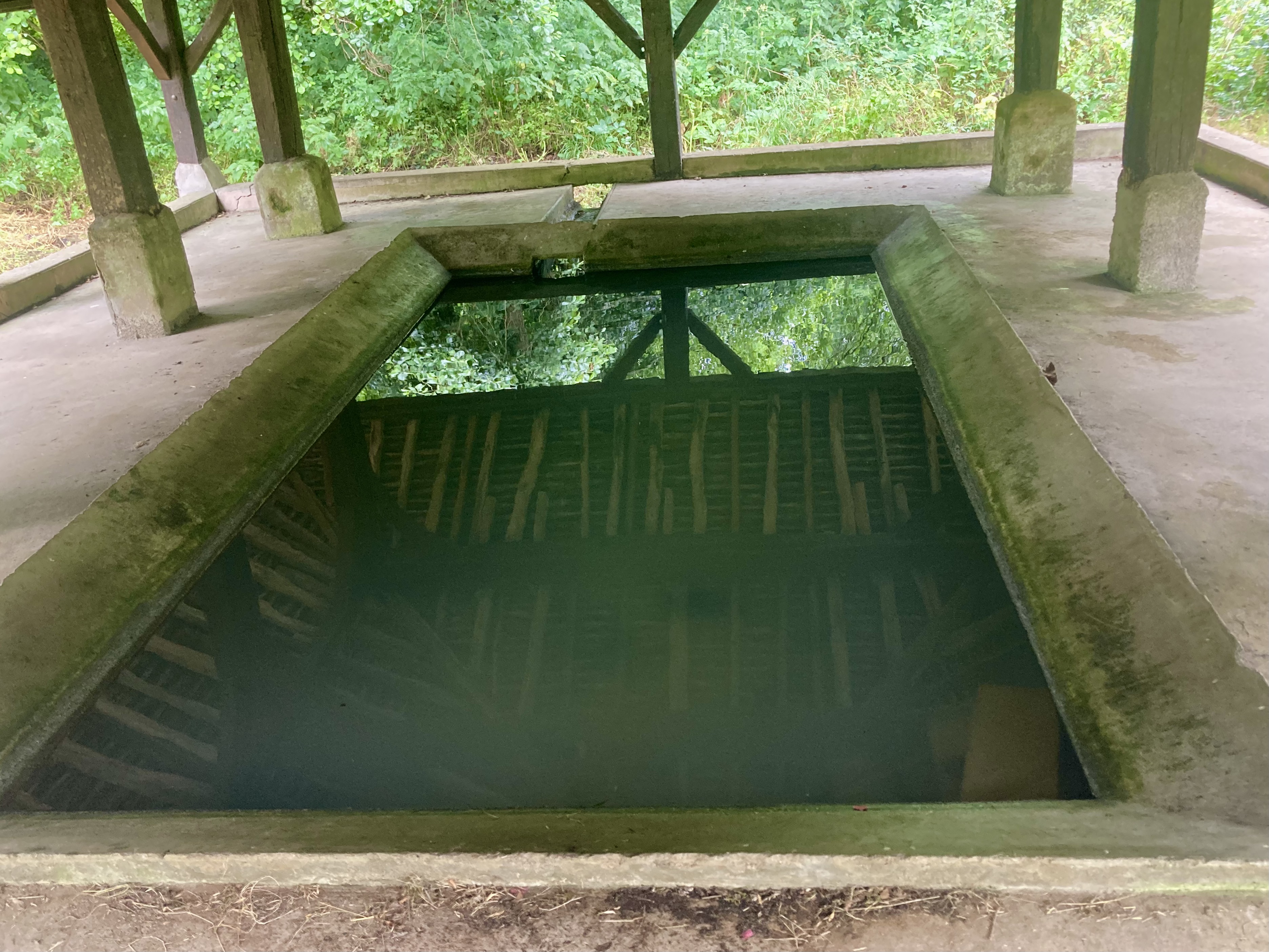
I had seen on the map that there was a lavoir, and look what a treat it was! It is set down below the canal, closer to the river Loing. There is a lovely small stream that comes out of the ground and runs into a sturdy, low roofed, square lavoir.
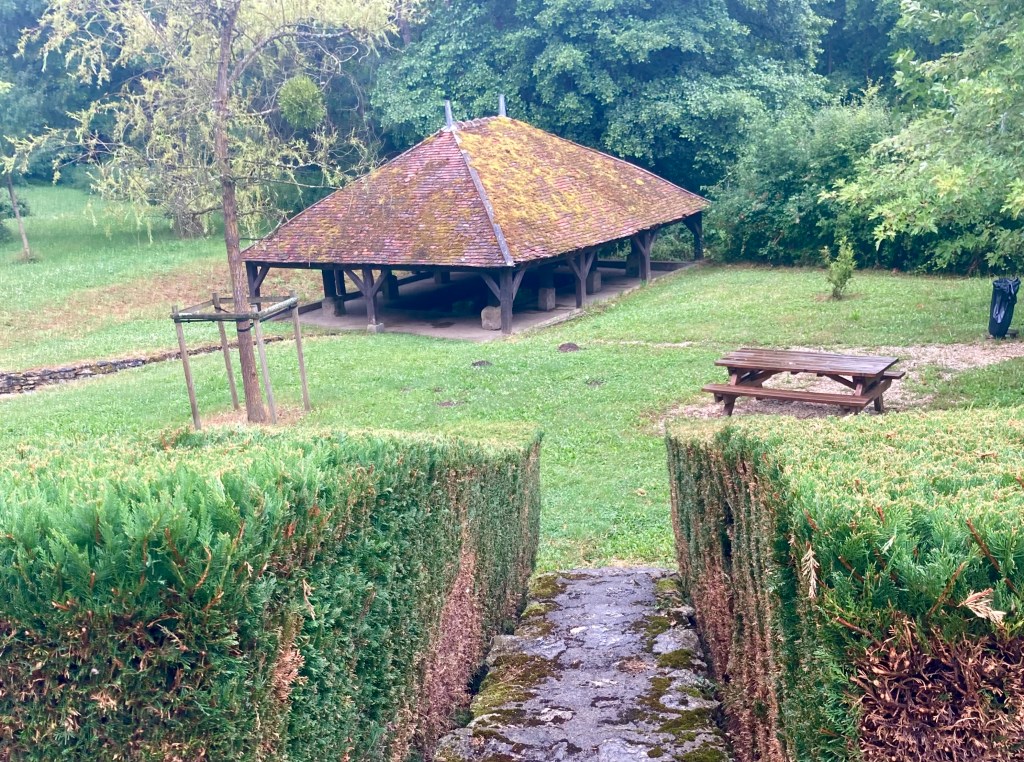
I suspect it has been made a bit more beautiful for tourists than it felt to the locals on a winter’s morning when there was a load of washing to be done.

We only stayed for the one night and were off in the morning towards Montbouy, through more lovely farmland, wondering what lay in store for us there.
Our choice of Montbouy meant that we passed through Chatillon-Coligny, a favourite place to stop for many people, but Montbouy was a better mid-stop between Dammarie and Montargis – the end of this canal.
At the edge of Chatillon is a lock that is not allowed to be automated because of its old manually operated lift bridge. The lock keeper was keen to show us how it operated, so here is a short video of him, on the left, in action. As he walked back onto the bridge it gently closed of it’s own volition, aided by well greased joints and gravity.
Montbouy

Montbouy had a couple of surprises for us. We were quickly moored up under a shady line of trees, and pleased that there were no hotel barges due that day to use the same space.
The one Boulanger was on holiday – fair enough, I am sure they deserve a break. So wraps came out of the cupboard for our midday sandwiches – always a good standby. I spotted a sign saying that a depot de pain was available at the épicerie (general store) over the road and marked that for next day.
After lunch, although it was quite hot, we agreed that we would go and look for the Gallo-roman amphitheatre shown on the map. I am sure you are as amazed as me to find this kind of archaeological site open to public view in a little village.



After about 25 minutes walk we found it, slightly fenced off, but easy to access and then dream about what happened there 2000 years ago.
Montbuoy was a delight in other ways too. The canal runs adjacent to the river Long here and looking across I noticed a familiar shape roof!



Yes, another lavoir; skip this if you are not a lavoir lover! This one had something I have never seen before – two interesting wooden contraptions that Stewart thinks might be some kind of mangle to squeeze the worst of the water out of the washing.

I amused myself with a photo of Calliope seemingly on the roof of the lavoir, combining two of my favourite things. (Not sure these would work in Julie Andrew’s song!) At the same time it does show the relationship of the canal to the river here in Montbouy.
Before saying good-bye to Montbouy my evening wander included two sundown views of the church – one from above and one from the bridge across the river.

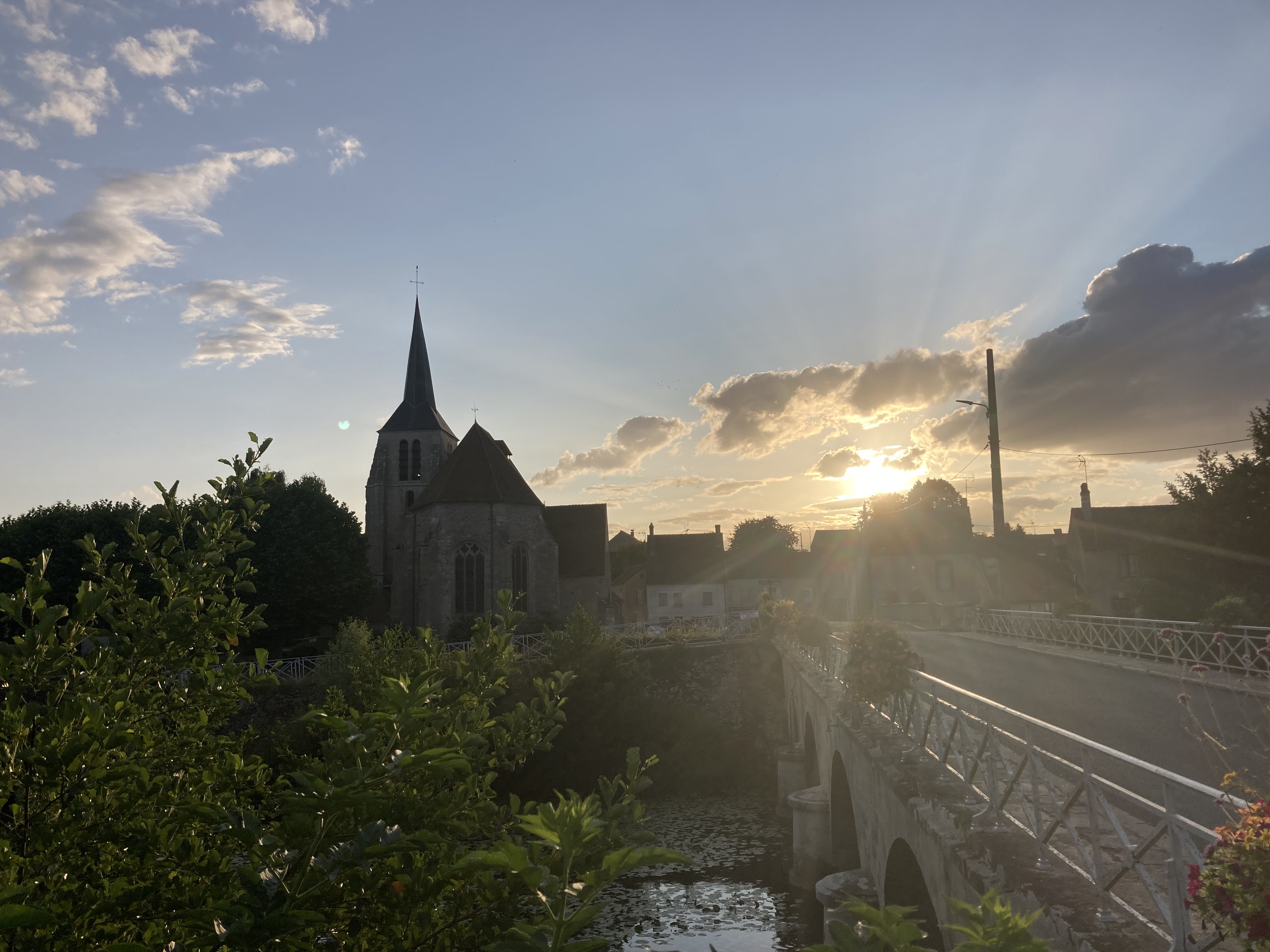
Montargis
The canal de Briare ends at Montargis, and continues on as the Canal de Loing (next blog). There was a 17kms to travel before we would see this famous town.
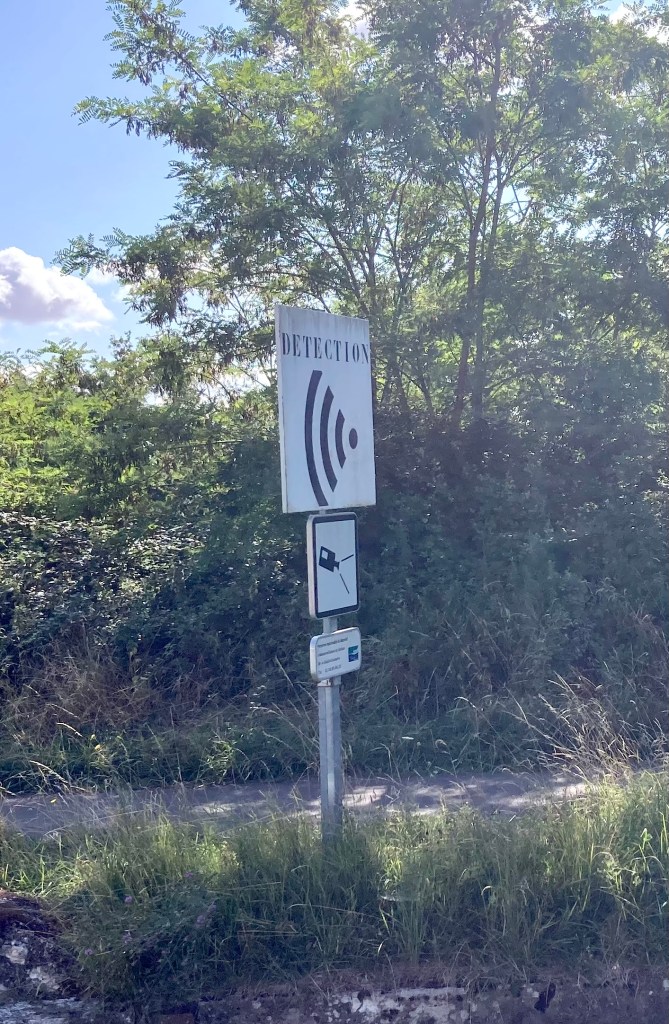

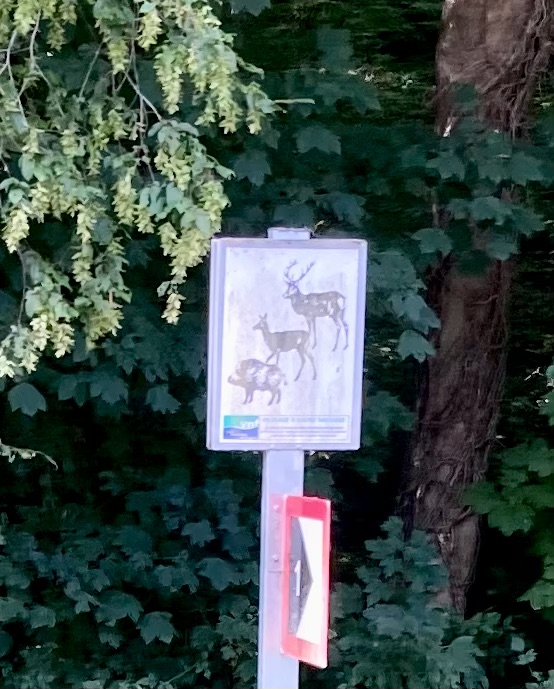
As always in addition to the ever changing landscape we had little interesting features along the way. We had these two canalside signs; the first made us smile as we knew we were detected! That was a good sign as it meant that the next lock knew we were approaching and would be ready for us.
The other sign, on the right, was above a set of ‘steps’ made to allow animals that have fallen into the canal a way to get back out. It looks like two types of deer and wild boar are most at risk.
I included the other photo, taken at lock No28 du Chesnoy to show how these lock keepers houses can deteriorate when no-one lives there; very sad.

And in a more artistic moment, at the bottom of a lock, I saw this very different type of mooring attachment – a hybrid of a ring and a bollard.

The port at Montargis is in the middle of a major redevelopment. Luckily there is one quay open to passing boats and we were able to take our place at the end of the row. And on quite a hot day we were pleased to be the ones who moored up under a shady tree!
Now we could get to know the town.

Montargis is simply a wonder! It is known as the Venice of the Gâtinais – an old province of France, long since divided up. It has been built on and around the rivers Loing and Vernisson; many small canals have been created between these two rivers, and these with the main Canals Briare and Loing have resulted in their Venice like atmosphere.

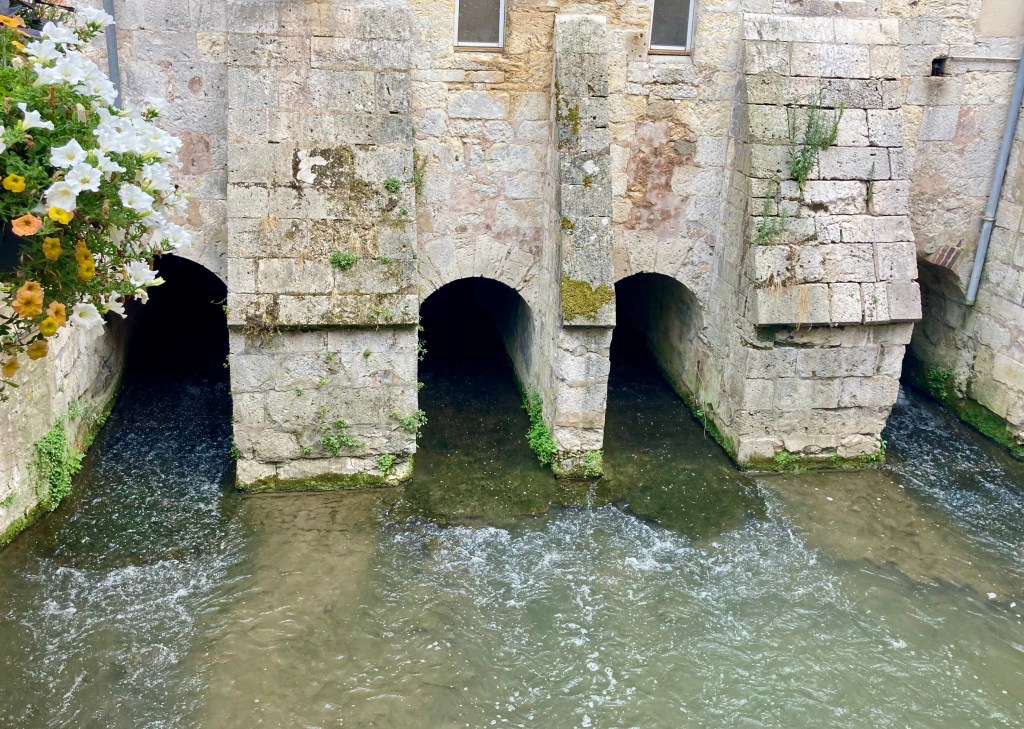


Here is just a flavour of some of these min-canals. Apparently there are over 100 bridges in Montargis – most of them beautifully decorated with flowers.
It is impossible to show all the water in the area. In addition to the rivers, that branch into many smaller ‘rivulets’, the main canal de Briare and all the little canals, there is also the Lac des Closiers. This is a big artificially created lake, using the water of the Loing; it is a great recreational area for all kinds of water and nature related activities.
We spent a little while on its peaceful shores on our way back from a shopping excursion.


There are many ancient buildings in Montargis too. In our short stay we did not get to see many but here are some.
A chateau overlooks the town, slightly marred by the orange rubble Shute down below.
Here is the magnificent entrance to the hospital
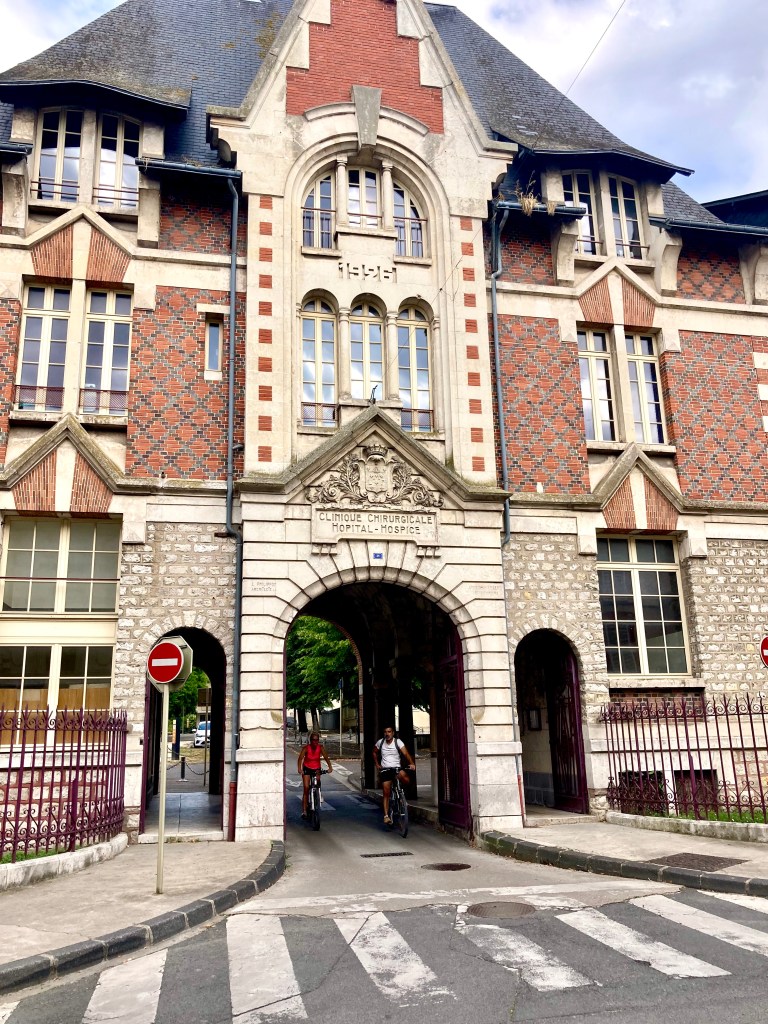



Probably my favourite was the Mazet chocolatier and sweet pastries shop. I watched the master at work in his shiny kitchen and took away some delicacies! It is a shop to seek out if you are in town.
All that sightseeing was thirsty work. We looked around for a typical French square with a bar or two, and were gving up hope until Stewart saw a sign for la Pêcherie. In its working heyday La Pêcherie was probably crowded, smelly and not much fun.

It was the area that the fishing people lived and worked in, moving their boats through the canals out onto the rivers to fish, and then bringing their catch back to be gutted and cleaned in the fresh flowing stream.
Now it is a popular place to eat and drink. A small ‘square’ surrounded by quirky little bars and restaurants, shaded by trees and umbrellas, and all the cooler for the water rushing by.
Looks like the Captain is pleased.

That was at the end of day two in Montargis, and time for us to move on to the Canal de Loing – a simple continuation of the Canal de Briare.
We really enjoyed the Canal de Briare – it was so much more than we expected with its lakes, lavoirs and ancient écluses, its villages and towns, full of surprises, and the countryside in between. A canal that we recommend.


